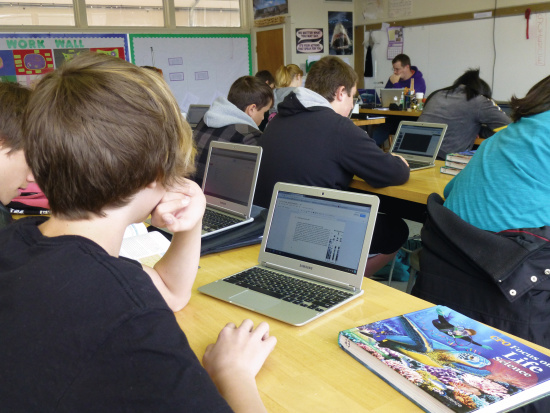
There’s a pretty interesting experiment going on at South Bay Middle School, the newish 7th/8th-grade charter on the campus of South Bay Elementary, across the highway from King Salmon.
Last month, the administration bought each kid in the school a $376 Chromebook for use on campus. The students check out their machine at the start of classes and carry it with them throughout the day. Teachers are moving their written assignments and grading to the cloud. According to the district superintendent, one English teacher hasn’t photocopied a single sheet of paper since the switch was made.
It’s the latest step in South Bay’s transition to a curriculum that puts technology at the forefront, and Superintendent Paul Meyers says everything’s going swimmingly so far.
“Kids are at school more, kids turning in assignments more … it has just revolutionized our classrooms,” Meyers told the Lost Coast Outpost earlier this week.
The money for the machines came from savings the school instituted last year, when districts around the state started saving up cash to prepare for the possibility of the failure of Proposition 30, the measure on last fall’s ballot that preserved funding for California’s educational system by raising sales taxes and income taxes on high earners. When Prop. 30 ended up passing, South Bay was one of the schools that found itself sitting on a pile of cash.
When it came time to look at what to do with that cash, laptop programs were at the top of its list. Public schools are constantly looking to distinguish their programs in this day and age, hoping to lure parents who have become accustomed to shopping around for their kids’ education. South Bay has positioned itself as a tech-centric school — it had previously secured a direct fiber-optic line to campus — and computers for kids was clearly its next priority. The administration looked at options, and eventually settled on the inexpensive Chromebooks, which also have the advantage of being wired into Google’s free suite of software services.
So have there been any downsides? Not many, according to Meyers. The kids’ computers are wired to connect to the Internet only through the Humboldt County Office of Education’s network, which is equipped with all the latest and greatest pornography filters. Someday soon the school hopes to set up proxies that will allow the kids to connect to this network through their home Internet connections.
Aren’t the devices distracting? Kids, like the rest of us, sometimes can’t help zoning out into the glowing screen sitting in front of them. But Meyers said that the faculty have developed a shorthand language for calling the kids to order: Devices out! Lids up! Lids down! Devices away! The students have no problem following orders, he said.
In any case, Meyers said, the benefits of having students wired into a world of research materials at their own desks far outweigh the downsides — and are probably more reflective of the actual world the students are coming into. One of the reasons he’s so excited about the program is that it levels the playing field. It’s not only the students from affluent neighborhoods who get to work with these tools. Between 60 and 70 percent of South Bay students qualify for the federally subsidized free and reduced lunch program, so the school is bringing modern equipment to a population that otherwise might not have access.
Meyers likened the Chromebooks to the little chalk tablets that students were issued 100 years ago — about the same size and shape, useful for all sorts of things, but infinitely more powerful. He expects them to become just as ubiquitous over the coming years.
“We’re probably the trailblazers right now, but I think other schools will be coming behind us next year,” he said.
CLICK TO MANAGE